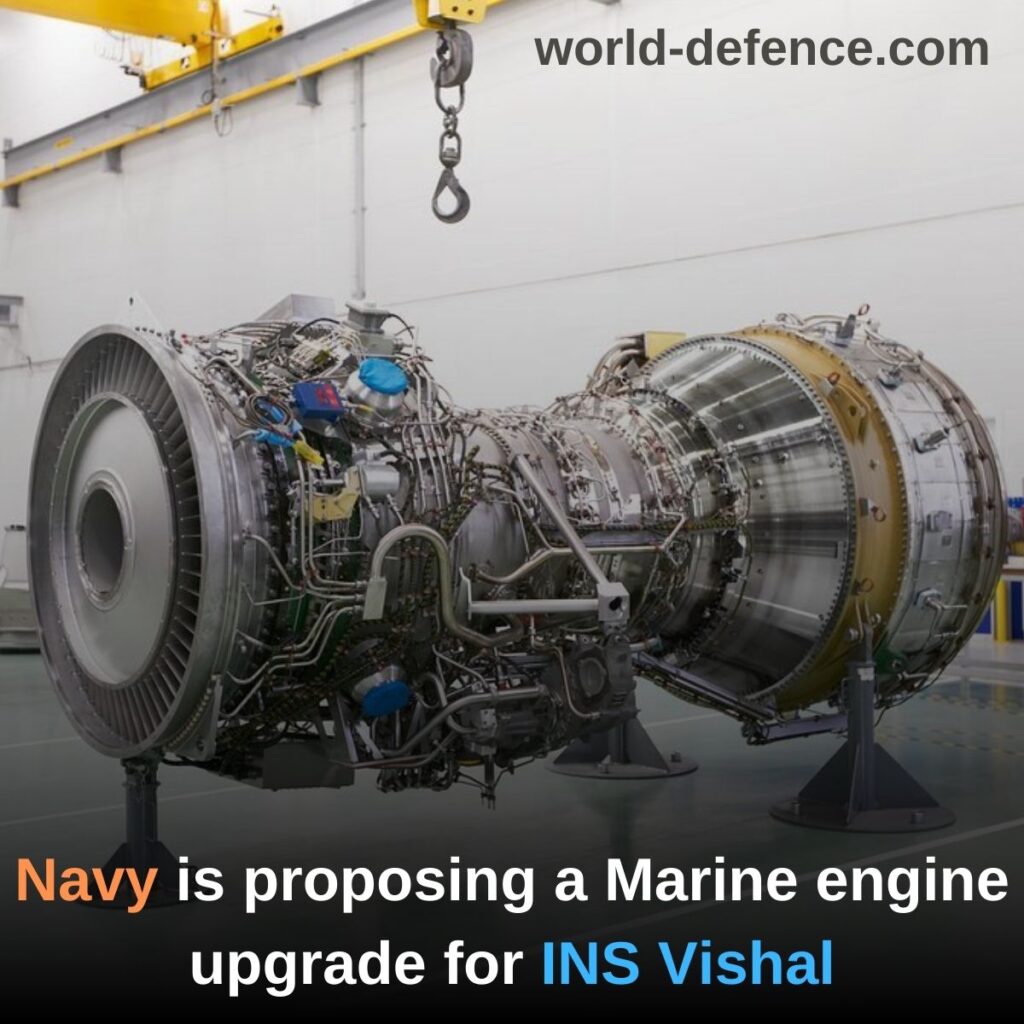According to media sources, the Indian Navy is considering installing a new high-powered marine engine to power the INS Vishal, replacing the General Electric LM25000 marine gas turbine engine that is now powering the INS Viraat.
The MT-30 marine engine produced by Rolls-Royce appears to be the leading candidate to replace two LM2500s aboard the second aircraft carrier. The MT-30 provides much greater power than the LM2500 and is expected to reduce maintenance expenses.
Numerous Indian warships are powered by the LM2500 marine engine, which is regarded as extremely dependable but is not considered a modern marine engine due to its 1960s-era technology.
READ MORE: Navy inducts sea-based Loitering munitions
The MT-30 marine engine is significantly more fuel-efficient than the LM2500, but it costs roughly 1.5 times as much. However, the MT-30 offers growth potential that will be useful when high-energy weaponry are integrated into prospective next-generation destroyers and frigates.
INS Vishal is a designed aircraft carrier for the Indian Navy that Cochin Shipyard Limited will construct. It is also renowned as Indigenous Aircraft Carrier 2 (IAC2). Following the INS Vikrant, it is projected to be India’s second aircraft carrier (IAC-1).
The proposed design for the second carrier will be a unique innovation with significant differences from Vikrant, such as expansion and displacement. A CATOBAR Electromagnetic Aircraft Launch System (EMALS) seems to be considered. Vishal is a Sanskrit term for “giant.”
The INS Vishal will make India the third country in the world, after the United States and France, to maintain a nuclear-powered aircraft carrier.
READ MORE: If India wants, Agni-5 missiles can now strike targets beyond 7,000 kms
Design and Development of INS Vishal
The design stage for INS Vishal (IAC-2) has commenced, with the navy’s ‘Naval Design Bureau’ in charge. The navy has opted against seeking outside assistance in developing the design concept and execution plans.
The navy may subsequently seek assistance from the Russian Design Bureau to incorporate Russian aircraft onboard Vishal.
Then the development and manufacturing of the aircraft carrier are taken by Cochin Shipyard Limited. IAC-II will be a flat-top carrier with a displacement of 65,000 tonnes, 25,000 tonnes more than Vikrant, and a CATOBAR system instead of IAC-STOBAR I’s system.
On the other hand, the INS Vishal would have a CATOBAR configuration (Catapult-Assisted Take-Off But Arrested Recovery) – a “flat-top” platform following American Navy models.
This layout would allow for heavier and bigger mission-minded fixed-wing aircraft, such as Airborne Early Warning (AEW) types, providing the Indian Navy with a competitive advantage in the South Asian-Pacific Theater.
READ MORE: India’s Heron UAVs to get Israeli Nimrod standoff strike ASM
Instrumental Details of INS Vishal
According to one commonly circulated report, INS Vishal would be a conventionally powered aircraft carrier powered by four General Electric LM2500+ series gas turbine engines driving two shafts. The top speed would be 28 knots in ideal conditions, with 7,500 nautical miles.
The vessel will be protected by four 76mm Otobreda guns, surface-to-air missile launchers, and a Close-In Weapon System (CIWS) like the 20mm American “Phalanx.” The comprehensive and innovative sensor and methodology will include a selex RAN-40L L-band early warning radar (EWR).
The operating length is 860 feet, with a width of 200 feet and a draught of 28 feet. The air wing of INS Vishal will be home to 30 or more fixed-wing aircraft and 10 rotary-wing helicopters.
The fixed-wing aircraft is believed to be a navalized version of the Russian Mikoyan MiG-29K Fulcrum or a navalized version of the land-based lightweight fighter.
However, the Indian Navy is also interested in bigger aircraft such as the Sukhoi Su-33, the Boeing F/A-18 Hornet, and the French Dassault Rafale to fit in the INS Vishal.
The INS Vishal has six key subsystems: the prime power interface, the launch motor, the power conversion electronics, the launch control, the energy storage system, and the energy distribution system. INS Vishal is also supported by the Electromagnetic Aircraft Launch System (EMALS).
READ MORE: General Atomics offers ToT for Niche tech of MQ-9B UAVs to India
The reason behind why India needs INS Vishal
- Obtaining and implementing critical emerging technologies of INS Vishal that may support diverse naval operations and enable improved performance efficiency would surely be the first step toward attaining India’s blue sea navy ambitions.
- For India, aircraft carriers act as more than just a method of showcasing military might in the Indo-Pacific; they also serve as less expensive alternatives to foreign military bases, guaranteeing that fighter aircraft and long-range surveillance are accessible on the ground in times of conflict.
- When evolved into Carrier Battle Groups (CBGs), naval fleets led by aircraft carriers become part of the country’s larger battle-readiness and tactical maritime doctrine, potentially destabilising enemy command, control, and counter-strike capabilities, according to the Indian Navy’s Indian Maritime Security Doctrine. In this context, CBGs deployed on Indigenous Aircraft Carrier 2 (IAC2) will complement India’s navy “Sea Control” doctrine, employing composite task groups to construct mobile airfields at sea.
Conclusion:
Moreover, it can be said INS Vishal is a modern aircraft with up to date in technology field. Naval planners estimate that when the INS Vishal enters service in the early 2030s, they should expect to operate UCAVs and an AEW aircraft and medium and light fighters from that carrier.
The aircraft carrier INS Vishal supports and operates aircraft that strike airborne, afloat and onshore targets that endanger free use of the sea and engage in long-term force projection operations.
According to a navy strategist (SEAD), it “might considerably expand our operation envelope with UCAVs, deploying the pilot-less vehicle for high-risk surveillance and destruction of enemy air defenses,”. Mid-air refuelling would allow us to maintain UCAVs on the mission for up to 36 hours.

